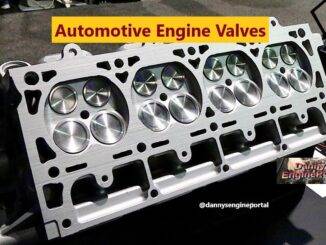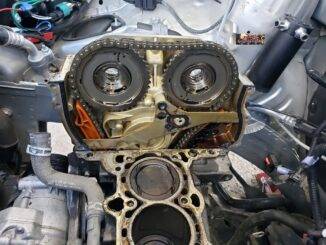
So, variable valve timing (VVT) adjusts the opening times and lift of the valves, to suit all operating conditions.
This ensures ideal charge cycles, within a wide range of engine speeds and loads.
Fuel consumption and emissions are reduced, while torque and smoothness are increased.
And, that’s how variable valve timing (VVT), provides a way of getting around, the limitations of fixed timing. So, valve timing determines, when the intake and exhaust valves open. Also, how long they stay open, and when they close. So, this is where (VVT) takes a front seat.
Some Of The Things That (VVT) Improves Include:
- The intake and exhaust flow.
- Intake manifold vacuum.
- The running compression.
- Volumetric efficiency.
- Throttle response.
- How much horsepower and torque the engine develops, at any given (RPM).
So, How Does Valve Overlap Affect Performance:
When You Have, More Valve Overlap, Then You Have:
- Reduces (NOx) emissions, under load.
- Increases (EGR) flow, lowering combustion temperatures.
- On some engines, (VVT) can eliminate the need for an (EGR) valve.
When You Have, Less Valve Overlap, Then You Have:
- Smooth idle, and more slow speed torque.
- Poor, high speed performance.
- Better engine breathing, at high speeds.
- Poor performance, at low speeds.
- Rough idle.
- Higher, exhaust emissions.
So, there are a variety of different (VVT) systems, in use today. But, different automakers use different (VVT) strategies, for different purposes.
Some Of The (VVT) Types Are:
- Cam Changing (VVT)
- Camshaft Phasing (VVT)
- Cam Changing + Cam Phasing (VVT)
- (VVC) System ( Unique To Rover )
So, in theory, maximum overlap is needed, between intake and exhaust valves opening, at high speed. However, when the car is running at medium cruising speed, maximum overlapping, may also be useful. Consequently, as a means to reduce fuel consumption and emission.
So, the exhaust valves do not close, until the intake valves have been open for a while. Therefore, the exhaust gases, are recirculated back into the cylinder, at the same time as the new air fuel mix is injected.
So, as part of the air fuel mix is replaced by exhaust gases, less fuel is needed. The exhaust gas, is made up of mostly non combustible gas. Then, the engine runs properly at the leaner air fuel mixture.
Variable Valve Timing (VVT), Common Problems
So, on (VVT) systems that use oil pressure to actuate the cam phaser, other issues can affect its operation. Some of these issues include: oil pressure, viscosity and contamination problems.
So, The Phaser May Not Work Properly If:
- The phaser does not receive, adequate oil pressure.
- Oil is the, wrong viscosity.
- The oil is, dirty.
This can hurt engine performance, fuel economy and emissions. And, may even turn on the check engine light (CEL), setting a (VVT) related (DTC).
Consequently, any (DTC) could be the result of a bad cam phaser, oil flow control valve or wiring faults.
P001 To P0099 (DTC)
So, the most common variable valve timing (VVT) trouble codes are P0011 and P0021.
What These Codes Mean:
P0011: Signifies a problem with the “A” camshaft (the intake camshaft) on the engine’s Bank 1. (the bank of cylinders containing cylinder one). The timing is too far advanced.
P0021: Indicates a similar timing over advanced issue, but for the “A” camshaft on Bank 2 of the engine.
So, don’t jump to any conclusions, regarding the variable valve timing (VVT) system. Because, if an engine is idling rough, or not developing power, you should also consider other possible causes.
These Causes May Include:
- A large, vacuum leak
- Heavy carbon buildup, on the intake valves
- Dirty, fuel injectors
- Low, fuel pressure
- Ignition, misfires
- Exhaust, restrictions
- Loss of, compression
- Turbo, problems
In Summary: Variable Valve Timing (VVT)
So, as you might have already guessed, (VVT) diagnostics is very application specific. And, it also depends on the configuration of the phaser and system electronics.
Above all, oil quality, viscosity and contamination problems, can all affect the operation of a, hydraulically actuated (VVT) cam phaser. Finally, this, in turn, will affect engine performance, fuel economy and emissions.
Thank You!




